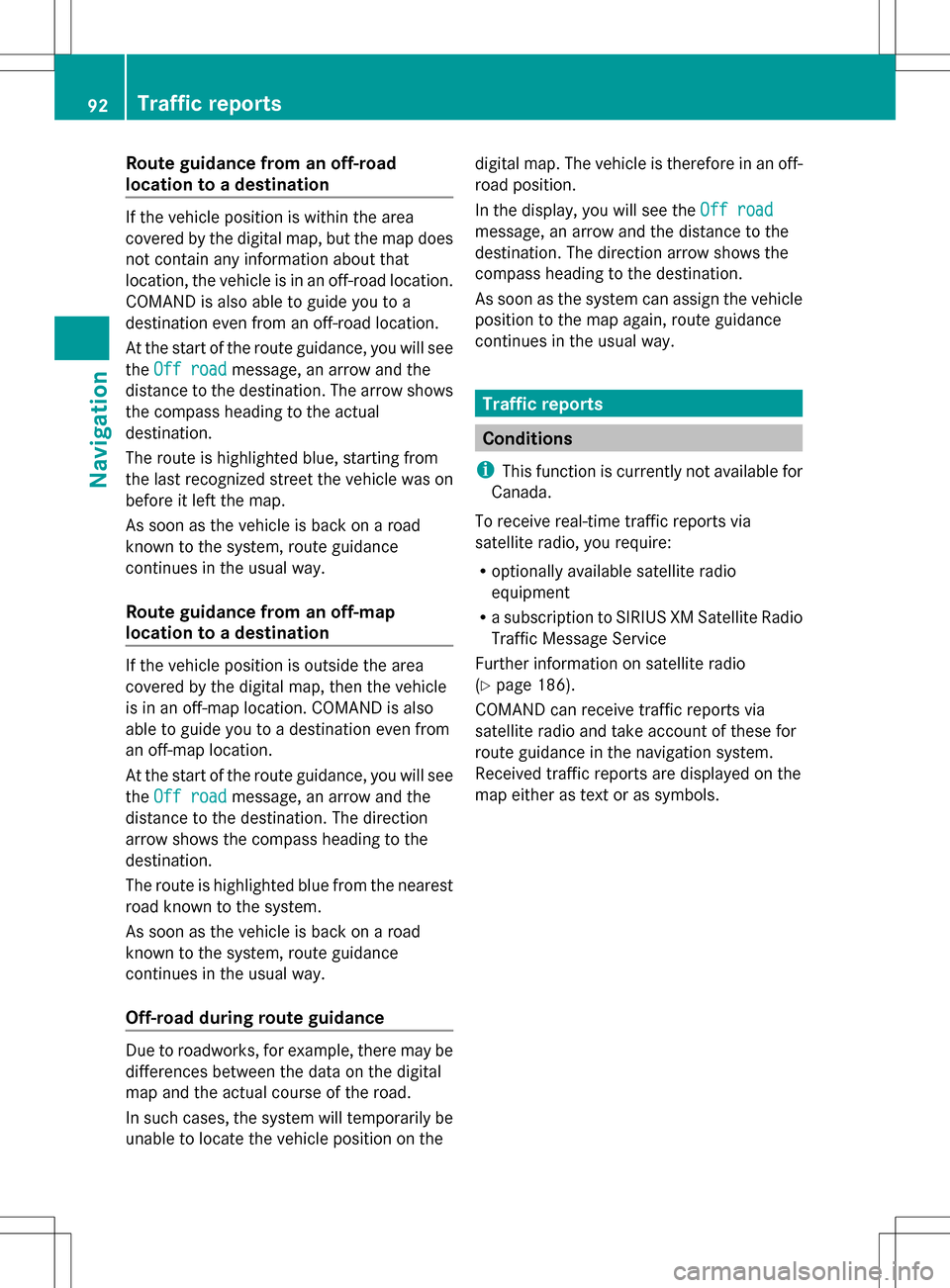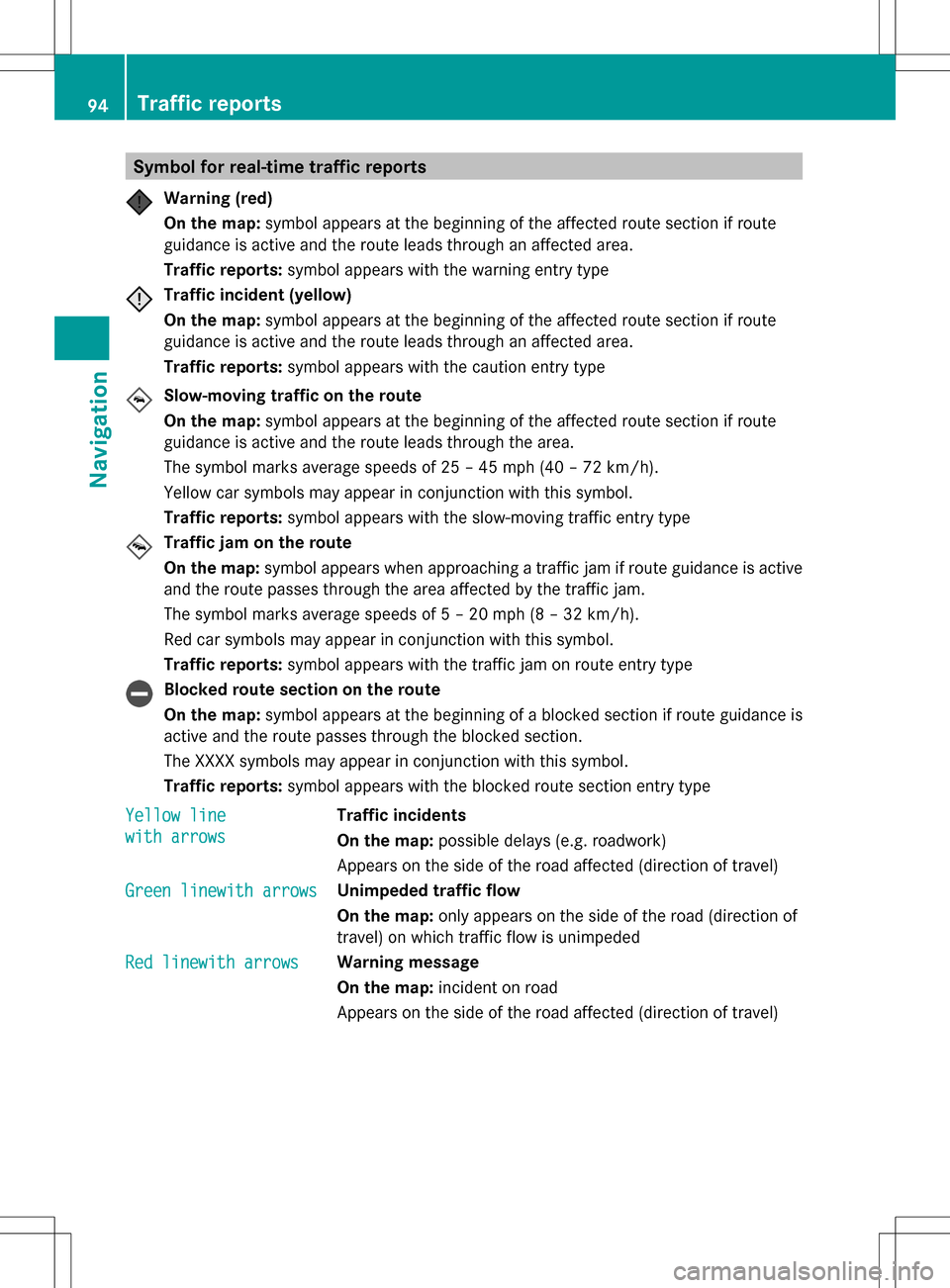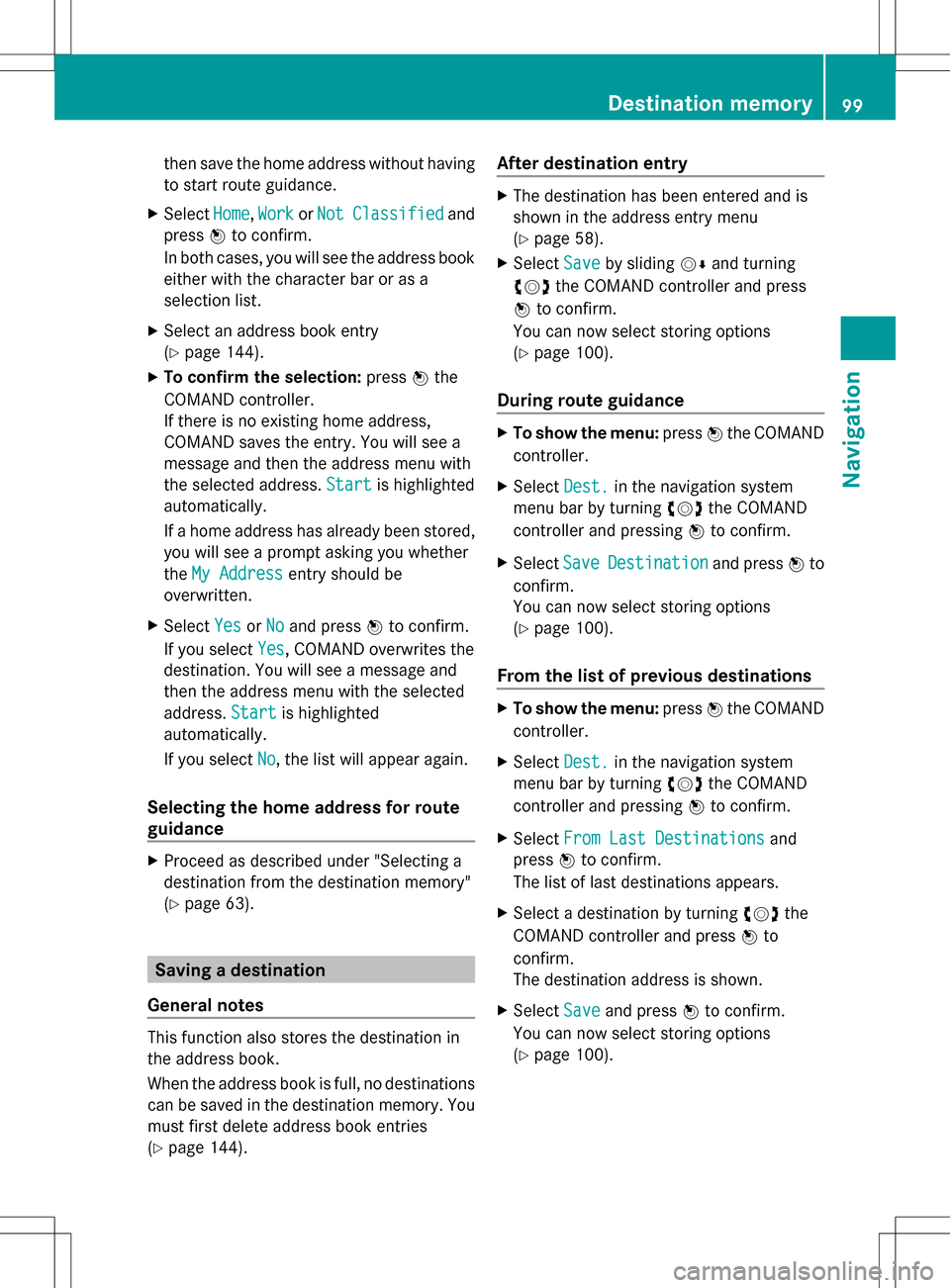2013 MERCEDES-BENZ E-Class Navigation
[x] Cancel search: NavigationPage 94 of 274

Route guidance from an off-road
location to a destination
If the vehicle position is within the area
covered by the digital map, but the map does
not contain any information about that
location, the vehicle is in an off-road location.
COMAND is also able to guide you to a
destination even from an off-road location.
At the start of the route guidance, you will see
the Off road
Off road message, an arrow and the
distance to the destination. The arrow shows
the compass heading to the actual
destination.
The route is highlighted blue, starting from
the last recognized street the vehicle was on
before it left the map.
As soon as the vehicle is back on a road
known to the system, route guidance
continues in the usual way.
Route guidance from an off-map
location to a destination If the vehicle position is outside the area
covered by the digital map, then the vehicle
is in an off-map location. COMAND is also
able to guide you to a destination even from
an off-map location.
At the start of the route guidance, you will see
the Off road
Off road message, an arrow and the
distance to the destination. The direction
arrow shows the compass heading to the
destination.
The route is highlighted blue from the nearest
road known to the system.
As soon as the vehicle is back on a road
known to the system, route guidance
continues in the usual way.
Off-road during route guidance Due to roadworks, for example, there may be
differences between the data on the digital
map and the actual course of the road.
In such cases, the system will temporarily be
unable to locate the vehicle position on the digital map. The vehicle is therefore in an off-
road position.
In the display, you will see the
Off road
Off road
message, an arrow and the distance to the
destination. The direction arrow shows the
compass heading to the destination.
As soon as the system can assign the vehicle
position to the map again, route guidance
continues in the usual way. Traffic reports
Conditions
i This function is currently not available for
Canada.
To receive real-time traffic reports via
satellite radio, you require:
R optionally available satellite radio
equipment
R a subscription to SIRIUS XM Satellite Radio
Traffic Message Service
Further information on satellite radio
(Y page 186).
COMAND can receive traffic reports via
satellite radio and take account of these for
route guidance in the navigation system.
Received traffic reports are displayed on the
map either as text or as symbols. 92
Traffic reportsNavigation
Page 95 of 274

Real-time traffic reports on the map
0043
Symbol delimiting the section of the route
affected
0044 Symbol indicating an incident on the route
(traffic flow)
0087 Destination
0085 Map scale
COMAND can show certain traffic incidents
on the map. Traffic reports are shown on the
map at scales of 0.05 mi to 20 mi.
X To hide the menu: slide00A0005Bthe COMAND
controller and, when the Full Screen
Full Screen
menu item is shown, press 00A1to confirm.
The map can be seen in the full-screen
display.
X Turn 0082005B0083 the COMAND controller until the
desired map scale is set. Traffic reports
93Navigation Z
Page 96 of 274

Symbol for real-time traffic reports
Warning (red)
On the map:
symbol appears at the beginning of the affected route section if route
guidance is active and the route leads through an affected area.
Traffic reports: symbol appears with the warning entry type Traffic incident (yellow)
On the map:
symbol appears at the beginning of the affected route section if route
guidance is active and the route leads through an affected area.
Traffic reports: symbol appears with the caution entry type Slow-moving traffic on the route
On the map:
symbol appears at the beginning of the affected route section if route
guidance is active and the route leads through the area.
The symbol marks average speeds of 25 – 45 mph (40 – 72 km/h).
Yellow car symbols may appear in conjunction with this symbol.
Traffic reports: symbol appears with the slow-moving traffic entry type Traffic jam on the route
On the map:
symbol appears when approaching a traffic jam if route guidance is active
and the route passes through the area affected by the traffic jam.
The symbol marks average speeds of 5 – 20 mph (8 – 32 km/h).
Red car symbols may appear in conjunction with this symbol.
Traffic reports: symbol appears with the traffic jam on route entry type Blocked route section on the route
On the map:
symbol appears at the beginning of a blocked section if route guidance is
active and the route passes through the blocked section.
The XXXX symbols may appear in conjunction with this symbol.
Traffic reports: symbol appears with the blocked route section entry type
Yellow line
Yellow line
with arrows with arrows Traffic incidents
On the map:
possible delays (e.g. roadwork)
Appears on the side of the road affected (direction of travel)
Green linewith arrows
Green linewith arrows Unimpeded traffic flow
On the map:
only appears on the side of the road (direction of
travel) on which traffic flow is unimpeded
Red linewith arrows
Red linewith arrows Warning message
On the map:
incident on road
Appears on the side of the road affected (direction of travel) 94
Traffic reportsNavigation
Page 97 of 274

Displaying real-time traffic reports
Calling up a list X
To switch to navigation mode: press the
00BE function button.
X To show the menu: press00A1the COMAND
controller.
X Select Traffic
Traffic by turning 0082005B0083the
COMAND controller and press 00A1to
confirm.
If the dialog field shows the "No Traffic
Messages" message, this means that:
R no traffic reports have been received yet.
R no traffic reports are available.
X To cancel the search: selectCancel
Cancel and
press 00A1to confirm.
X To close the report window: selectOK OK
and press 00A1to confirm.
If traffic reports exist, a list is shown.
The content of the list varies depending on
whether route guidance is active or not.
List when route guidance is not active The list shows all the roads, areas or regions
for which reports are available.
A traffic report may refer to an area or a
region, e.g. if visibility is impaired due to fog.
X Calling up a list( Ypage 95)
X To read a traffic report: select a road,
area or region by turning 0082005B0083the
COMAND controller and press 00A1to
confirm. List when route guidance is active
The first list shows the roads, areas and
regions that lie along the route and for which
traffic reports are available.
X
Call up a list ( Ypage 95).
X To show all reports: selectDisplay Display All
All
Messages
Messages by turning 0082005B0083the COMAND
controller and press 00A1to confirm.
You see a list of all roads, areas and regions
for which traffic reports are available, even
if the reports do not affect your route. X
To show a traffic report: select a road,
area or region and press 00A1to confirm.
X To close the list: slide009E005B009F the COMAND
controller. Traffic
reports
95Navigation Z
Page 98 of 274

Example: traffic report
0043
Depending on your selection: Messages
Messages
On Route
On Route orAll Messages
All Messages
0044 Report 8 of 16 for the road affected
0087 Report text
0085 Road, area or region affected by traffic
reports
0083 Symbol for state/province
0084 Symbol for report type, e.g. traffic flow
message
X To scroll within a report or to access
the next report: turn0082005B0083 the COMAND
controller.
X To return to the report list: slide009E005B009F the
COMAND controller.
Displaying traffic reports on the map Example: traffic symbol information on the map
0043 Affected roads with indication of direction
0044 Symbol for report type, e.g. traffic flow
message X
Select Traffic Symbol Information
Traffic Symbol Information by
turning 0082005B0083the COMAND controller and
press 00A1to confirm. Example: details on traffic symbol information
X
Select Next NextorPrevious
Previous by turning 0082005B0083
the COMAND controller and press 00A1to
confirm in order to continue highlighting
traffic symbols.
X To change the map scale: selectMap Mapby
sliding 00A0005Bthe COMAND controller and
press 00A1to confirm.
You can now zoom in or out of the map.
X To show the detailed view: select
Details
Details and press 00A1to confirm.
X To close the detailed view: slide009E005B009F the
COMAND controller. Reading out traffic reports on the
route
Introduction The read-aloud function is only available while
route guidance is active. It reads out traffic
reports affecting the current route.
You can select the following text reader
properties:
R
Language (Y page 40)
R Text reader speed ( Ypage 39)
You can start the text reader function
manually or set it to automatic. 96
Traffic reportsNavigation
Page 99 of 274

Starting the text reader function
manually
X
To switch to navigation mode: press the
00BE function button.
X To show the menu: press00A1the COMAND
controller.
X Select Traffic
Traffic by turning 0082005B0083the
COMAND controller and press 00A1to
confirm.
X Select Read out all messages on
Read out all messages on
route route and press 00A1to confirm.
COMAND reads out the reports in
sequence.
i If there are no reports for the route, the
Read
Read out outall
allmessages
messages on
onroute
route menu
item is shown in gray and cannot be
selected.
X To switch off the read-aloud function:
select Cancel Cancel read-aloud
read-aloud function
functionand
press 00A1to confirm or press the 006C
button.
COMAND reads out the current report and
then exits the read-aloud function.
Automatic read-aloud function X
To switch to navigation mode: press the
00BE function button.
X To show the menu: press00A1the COMAND
controller.
X Select Navi
Navi by sliding 00A0005Band turning
0082005B0083 the COMAND controller and press
00A1 to confirm.
X Select Read Traffic Messages
Read Traffic Messages
Automatically Automatically and press00A1to confirm.
Depending on the previous state, switch
the option on 0073or off 0053. Recalculating the route dynamically
The route types
Dynamic Route
Dynamic Route and
Dynamic
Dynamic Route
RouteOnly
OnlyAfter
After Request
Request take
all relevant traffic messages into account
when calculating a route (Y page 56).
If you have set the route type Dynamic Dynamic
Route
Route, COMAND guides you on the updated
route to your destination.
If you have set the route type Dynamic Dynamic
Route Only After Request
Route Only After Request, a prompt
appears.
You can now decide whether to:
R accept the route suggested by COMAND
R continue your original route
X To accept the suggested route: press
00A1 the COMAND controller.
X To continue along the original route:
select Reject
Reject by turning 0082005B0083the
COMAND controller and press 00A1to
confirm. Destination memory
Home address (My address)
Entering the home address via address
entry X
Proceed as described under “Adopting an
address book entry as a home address”
(Y page 98). Confirm My Address
My Address by
pressing 00A1.
X To enter the home address for the first
time: confirm New Entry New Entry by pressing 00A1. Destination memory
97Navigation Z
Page 100 of 274

X
To change the home address: select
Change
Change in the menu showing the home
address by turning 0082005B0083the COMAND
controller and press 00A1to confirm.
X Confirm New Entry
New Entry by pressing 00A1.
X In both cases, enter the home address as a
destination, e.g. as a city, street and house
number (Y page 58). Then, save the home
address (Y page 63).
Adopting an address book entry as a
home address X
To switch on navigation mode: press the
00BE function button.
X To show the menu: press00A1the COMAND
controller.
X Select Dest.
Dest. in the navigation system
menu bar by turning 0082005B0083the COMAND
controller and pressing 00A1to confirm.
X Select From Memory
From Memory and press00A1to
confirm.
You will see the destination memory list
either with the character bar (option 1) or
as a selection list (option 2).
Option 1: destination memory list with
character bar X
Slide 005B00A0the COMAND controller
repeatedly until the destination memory
list appears as a selection list.
Option 2: destination memory list as
selection list The
My Address My Address entry is listed as the first
entry in the destination memory.
X Select My Address My Address by turning0082005B0083the
COMAND controller and press 00A1to
confirm.
i If you have not yet entered any
characters, My Address
My Address is automatically
highlighted in the selection list.
If no home address has been stored yet, you
can now assign an address book entry. If a
home address already exists, it is displayed
and you can alter it.
i If you select New Entry New Entry, you are also
offered the option of entering the home
address for the first time. You can then
save the home address without having to
start route guidance.
X To enter the home address for the first
time: select Assign to Address Book Assign to Address Book
Entry
Entry and press 00A1to confirm.
X Select Home
Home,Work
WorkorNot
Not Classified
Classified and
press 00A1to confirm.
X To change the home address: select
Change
Change and press 00A1to confirm.
X Select Assign to Address Book Entry
Assign to Address Book Entry
and press 00A1to confirm.
i If you select New Entry
New Entry , you are also
offered the option of changing the home
address by entering an address. You can 98
Destination memoryNavigation
Page 101 of 274

then save the home address without having
to start route guidance.
X Select Home
Home, Work WorkorNot
Not Classified
Classified and
press 00A1to confirm.
In both cases, you will see the address book
either with the character bar or as a
selection list.
X Select an address book entry
(Y page 144).
X To confirm the selection: press00A1the
COMAND controller.
If there is no existing home address,
COMAND saves the entry. You will see a
message and then the address menu with
the selected address. Start
Start is highlighted
automatically.
If a home address has already been stored,
you will see a prompt asking you whether
the My Address
My Address entry should be
overwritten.
X Select Yes YesorNo
No and press 00A1to confirm.
If you select Yes
Yes , COMAND overwrites the
destination. You will see a message and
then the address menu with the selected
address. Start
Start is highlighted
automatically.
If you select No No, the list will appear again.
Selecting the home address for route
guidance X
Proceed as described under "Selecting a
destination from the destination memory"
(Y page 63). Saving a destination
General notes This function also stores the destination in
the address book.
When the address book is full, no destinations
can be saved in the destination memory. You
must first delete address book entries
(Y page 144). After destination entry X
The destination has been entered and is
shown in the address entry menu
(Y page 58).
X Select Save Saveby sliding 005B0064and turning
0082005B0083 the COMAND controller and press
00A1 to confirm.
You can now select storing options
(Y page 100).
During route guidance X
To show the menu: press00A1the COMAND
controller.
X Select Dest.
Dest. in the navigation system
menu bar by turning 0082005B0083the COMAND
controller and pressing 00A1to confirm.
X Select Save
Save Destination Destination and press00A1to
confirm.
You can now select storing options
(Y page 100).
From the list of previous destinations X
To show the menu: press00A1the COMAND
controller.
X Select Dest.
Dest. in the navigation system
menu bar by turning 0082005B0083the COMAND
controller and pressing 00A1to confirm.
X Select From Last Destinations From Last Destinations and
press 00A1to confirm.
The list of last destinations appears.
X Select a destination by turning 0082005B0083the
COMAND controller and press 00A1to
confirm.
The destination address is shown.
X Select Save Saveand press 00A1to confirm.
You can now select storing options
(Y page 100). Destina
tion memory
99Navigation Z